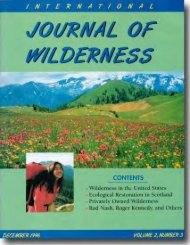Download full PDF - International Journal of Wilderness
Download full PDF - International Journal of Wilderness
Download full PDF - International Journal of Wilderness
Create successful ePaper yourself
Turn your PDF publications into a flip-book with our unique Google optimized e-Paper software.
Figure 1—The Anza-Borrego Desert State Park in Southern California has 386,000 acres (156,275 ha.) <strong>of</strong> designated state<br />
wilderness ( 2 /3 <strong>of</strong> the park) in 12 subunits. Shown above is a Palm Oasis in wilderness in the Borrego Palm Canyon<br />
wilderness unit <strong>of</strong> the park. Photo by Marilyn Riley.<br />
state wilderness must appear to have<br />
been primarily affected by the forces<br />
<strong>of</strong> nature, with the evidence <strong>of</strong> humans<br />
being substantially unnoticeable or<br />
where the evidence <strong>of</strong> humans could<br />
be eliminated by restoration. Similarly,<br />
in Alaska, resource modification<br />
California<br />
within a wilderness zone <strong>of</strong> a state park<br />
was permitted to restore the area to a<br />
natural condition. The California legislation<br />
provides for the admission <strong>of</strong><br />
areas where previous impacts had<br />
been already remedied or substantially<br />
restored to a near natural appearance.<br />
The California legislature established the California <strong>Wilderness</strong> Preservation<br />
System (CWPS) in 1974. Three basic criteria govern admission to the system:<br />
(l) the land must be state owned; (2) the area must remain in, or have been<br />
returned to, or have substantially reestablished its principal, natural character,<br />
and influence; and (3) the area must be <strong>of</strong> sufficient size to make its preservation<br />
practicable. The 1974 legislation created two wilderness areas: the Santa Rosa<br />
Mountains <strong>Wilderness</strong> Area <strong>of</strong> about 87,000 acres (35,223 ha.) and the l0,000acre<br />
(4,049 ha.) Mount San Jacinto <strong>Wilderness</strong> Area abutting the federally<br />
designated San Jacinto <strong>Wilderness</strong>. The CWPS is small compared to the federal<br />
wilderness acreage in the state, with 466,320 acres (188,794 ha.) in state ownership<br />
by 2002 as compared to 14 million acres (5.7 million ha.) administered<br />
by federal agencies in 2000. The types <strong>of</strong> wilderness areas in the California<br />
state system are an important complement to those in the National <strong>Wilderness</strong><br />
Preservation System. Much <strong>of</strong> the land in the state system is in the Anza-Borrego<br />
Desert State Park; other areas are along the coastline and in mountain ranges<br />
along the coast. The CWPS adds to the broad diversity <strong>of</strong> ecosystems under<br />
wilderness protection.<br />
22 <strong>International</strong> <strong>Journal</strong> <strong>of</strong> <strong>Wilderness</strong> DECEMBER 2002 • VOLUME 8, NUMBER 3<br />
By 1994 eight <strong>of</strong> the nine state<br />
wilderness programs studied by<br />
Stankey in 1983 were still operating<br />
(Peterson 1996). Florida had its wilderness<br />
legislation repealed when it<br />
came up for reauthorization in 1989,<br />
and the 10 wilderness areas there<br />
were transferred to other state land<br />
management programs. In 1994, 58<br />
areas and 3.1 million acres (1.3 million<br />
ha.) were established in the<br />
eight remaining state programs.<br />
State Survey on <strong>Wilderness</strong><br />
Programs in 2002<br />
We contacted the nine states identified<br />
by Stankey (1984) as having a<br />
state-designated wilderness system.<br />
Through a combination <strong>of</strong> telephone<br />
interviews and mail surveys during<br />
2002, we documented changes in<br />
number <strong>of</strong> areas and acreages, and<br />
asked about the types <strong>of</strong> techniques<br />
used to manage visitor use and perceived<br />
threats to wilderness resources<br />
and values. Additionally, we contacted<br />
land management agencies in the<br />
other states to determine if recent legislation<br />
had created new state wilderness<br />
systems or designated individual<br />
wilderness areas.<br />
In 2002, there were seven state wilderness<br />
programs still operating from<br />
the original nine studied by Stankey<br />
in 1983 (see Table 1). As noted previously,<br />
Florida no longer had a wilderness<br />
program and Minnesota was no<br />
longer listed in 2002 because there<br />
were no state-designated wilderness<br />
areas. Although previous studies reported<br />
that Minnesota state-owned<br />
land located within the federal Boundary<br />
Waters Canoe Area was a state wilderness,<br />
recent interviews and<br />
contacts with authorities in Minnesota<br />
indicated that it was never so designated<br />
by the state legislature.<br />
The number <strong>of</strong> states with wilderness<br />
programs had declined since 1983, but










